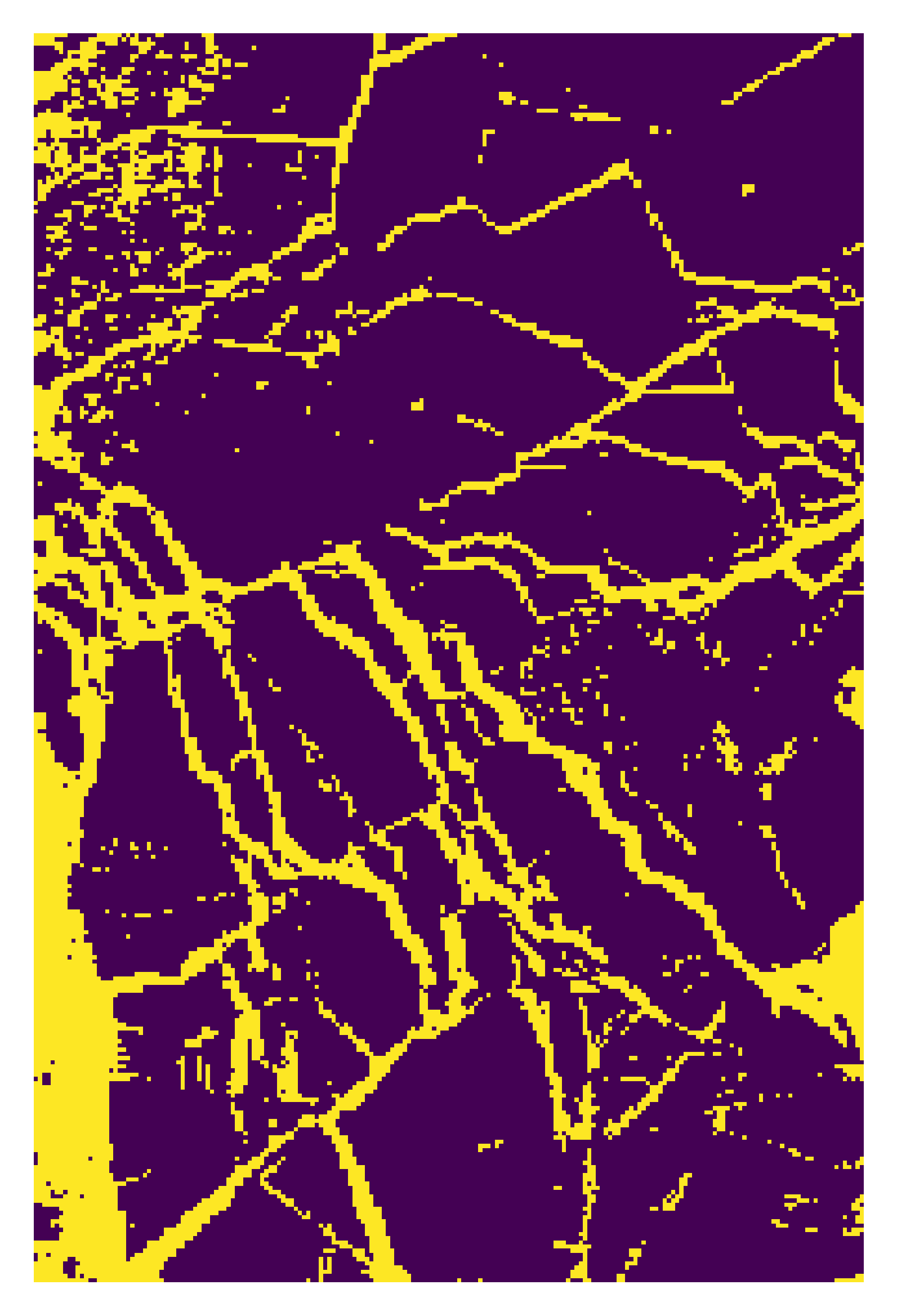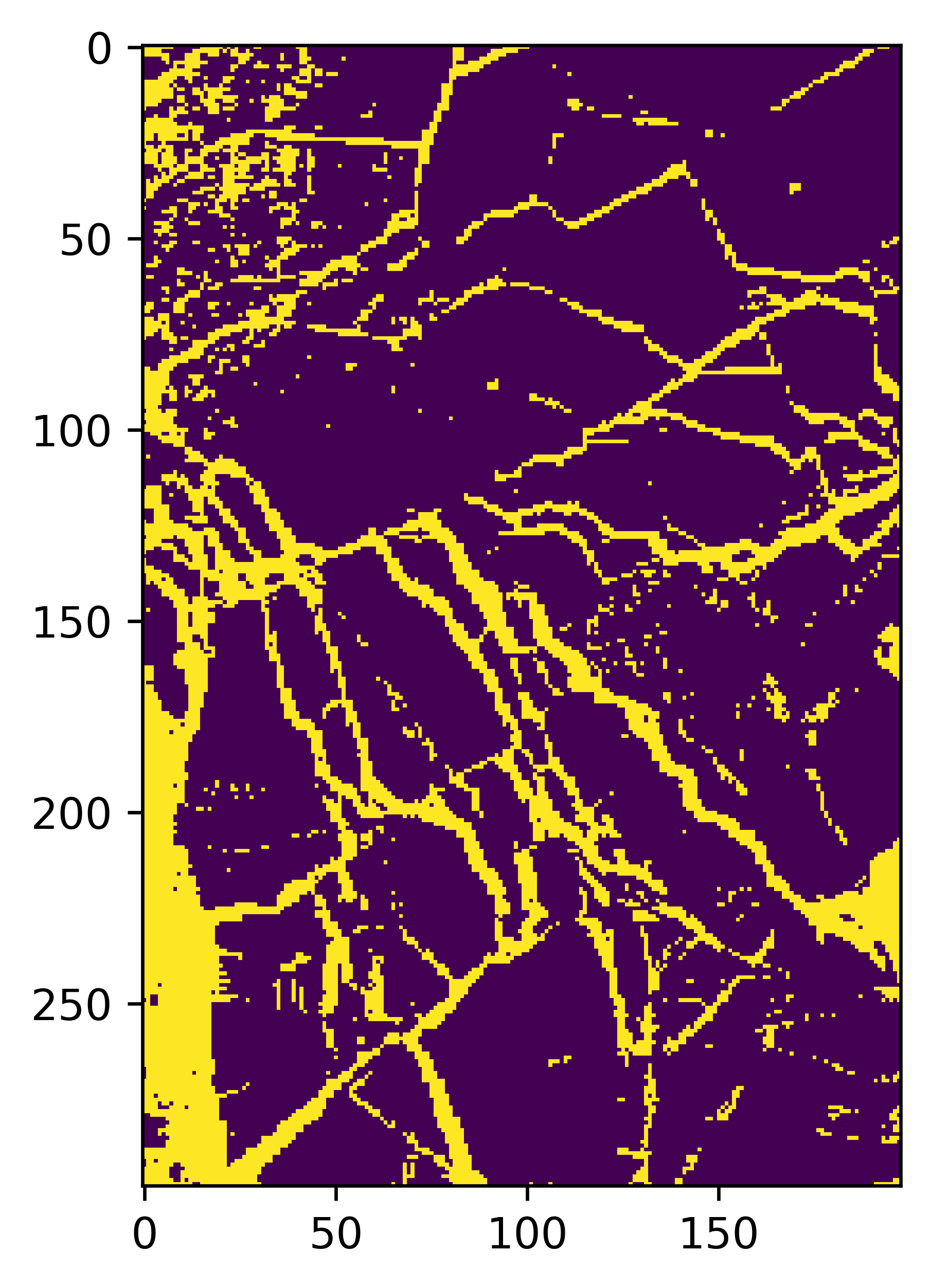Roll-out on a Full Image#
📘 Interactive Version: For a hands-on experience with this chapter’s content, access the interactive notebook in Google Colab.
Introduction#
Applying machine learning models to entire, full-sized images—especially in the realm of image processing—presents a distinct set of challenges and opportunities. Such a “roll-out” doesn’t just involve stretching a model’s capabilities across larger pixel dimensions; it tests the model’s capacity to consistently and correctly generate outputs, be it segmentation or classification maps, across varying regions of an image.
Preparation#
Here, we need to process the image to be rolled-out into the shape that is compatible to our model input shape. For example, the model input shape is
(3, 3, 21). The below code is for processing the data.
from google.colab import drive
drive.mount('/content/drive')
Mounted at /content/drive
pip install netCDF4
Collecting netCDF4
Downloading netCDF4-1.7.2-cp311-cp311-manylinux_2_17_x86_64.manylinux2014_x86_64.whl.metadata (1.8 kB)
Collecting cftime (from netCDF4)
Downloading cftime-1.6.4.post1-cp311-cp311-manylinux_2_17_x86_64.manylinux2014_x86_64.whl.metadata (8.7 kB)
Requirement already satisfied: certifi in /usr/local/lib/python3.11/dist-packages (from netCDF4) (2024.12.14)
Requirement already satisfied: numpy in /usr/local/lib/python3.11/dist-packages (from netCDF4) (1.26.4)
Downloading netCDF4-1.7.2-cp311-cp311-manylinux_2_17_x86_64.manylinux2014_x86_64.whl (9.3 MB)
━━━━━━━━━━━━━━━━━━━━━━━━━━━━━━━━━━━━━━━━ 9.3/9.3 MB 85.9 MB/s eta 0:00:00
?25hDownloading cftime-1.6.4.post1-cp311-cp311-manylinux_2_17_x86_64.manylinux2014_x86_64.whl (1.4 MB)
━━━━━━━━━━━━━━━━━━━━━━━━━━━━━━━━━━━━━━━━ 1.4/1.4 MB 68.7 MB/s eta 0:00:00
?25hInstalling collected packages: cftime, netCDF4
Successfully installed cftime-1.6.4.post1 netCDF4-1.7.2
Model Application#
In this phase, the trained model processes the entire image, generating outputs that classify the different regions into respective categories such as sea-ice and leads. Let’s say your saved model is called cnn_model or vit_model. You can load in different models you have trained in Week 2.
Load in CNN#
import tensorflow as tf
# Load in trained CNN model
cnn_model = tf.keras.models.load_model('/content/drive/MyDrive/GEOL0069/2425/Week 2/Week2_AI_Algorithms/modelCNN.h5')
WARNING:absl:Compiled the loaded model, but the compiled metrics have yet to be built. `model.compile_metrics` will be empty until you train or evaluate the model.
Load in ViT#
import numpy as np
import tensorflow as tf
from tensorflow import keras
from tensorflow.keras import layers
from sklearn.ensemble import RandomForestClassifier
from sklearn.metrics import accuracy_score,confusion_matrix,classification_report
from keras.saving import register_keras_serializable
#=========================================================================================================
#=========================================================================================================
#=========================================================================================================
def mlp(x, hidden_units, dropout_rate):
for units in hidden_units:
x = layers.Dense(units, activation=tf.nn.gelu)(x)
x = layers.Dropout(dropout_rate)(x)
return x
@register_keras_serializable()
class Patches(layers.Layer):
def __init__(self, patch_size, **kwargs):
super().__init__(**kwargs)
self.patch_size = patch_size
def call(self, images):
batch_size = tf.shape(images)[0]
patches = tf.image.extract_patches(
images=images,
sizes=[1, self.patch_size, self.patch_size, 1],
strides=[1, self.patch_size, self.patch_size, 1],
rates=[1, 1, 1, 1],
padding="VALID",
)
patch_dims = patches.shape[-1]
patches = tf.reshape(patches, [batch_size, -1, patch_dims])
return patches
def get_config(self):
config = super().get_config()
config.update({"patch_size": self.patch_size})
return config
@register_keras_serializable()
class PatchEncoder(layers.Layer):
def __init__(self, num_patches, projection_dim, **kwargs):
super().__init__(**kwargs)
self.num_patches = num_patches
self.projection_dim = projection_dim
self.projection = layers.Dense(units=projection_dim)
self.position_embedding = layers.Embedding(
input_dim=num_patches, output_dim=projection_dim
)
def call(self, patch):
positions = tf.range(start=0, limit=self.num_patches, delta=1)
encoded = self.projection(patch) + self.position_embedding(positions)
return encoded
def get_config(self):
config = super().get_config()
config.update({
"num_patches": self.num_patches,
"projection_dim": self.projection_dim
})
return config
#=========================================================================================================
#=========================================================================================================
#=========================================================================================================
def create_vit_classifier():
inputs = layers.Input(shape=input_shape)
# Augment data.
augmented = more_data(inputs)
# Create patches.
patches = Patches(patch_size)(augmented)
# Encode patches.
encoded_patches = PatchEncoder(num_patches, projection_dim)(patches)
# Create multiple layers of the Transformer block.
for _ in range(transformer_layers):
# Layer normalization 1.
x1 = layers.LayerNormalization(epsilon=1e-6)(encoded_patches)
# Create a multi-head attention layer.
attention_output = layers.MultiHeadAttention(
num_heads=num_heads, key_dim=projection_dim, dropout=0.1
)(x1, x1)
# Skip connection 1.
x2 = layers.Add()([attention_output, encoded_patches])
# Layer normalization 2.
x3 = layers.LayerNormalization(epsilon=1e-6)(x2)
# MLP.
x3 = mlp(x3, hidden_units=transformer_units, dropout_rate=0.1)
# Skip connection 2.
encoded_patches = layers.Add()([x3, x2])
# Create a [batch_size, projection_dim] tensor.
representation = layers.LayerNormalization(epsilon=1e-6)(encoded_patches)
representation = layers.Flatten()(representation)
representation = layers.Dropout(0.5)(representation)
# Add MLP.
features = mlp(representation, hidden_units=mlp_head_units, dropout_rate=0.5)
# Classify outputs.
logits = layers.Dense(num_classes)(features)
# Create the Keras model.
model = keras.Model(inputs=inputs, outputs=logits)
return model
#=========================================================================================================
#=========================================================================================================
#=========================================================================================================
def run_experiment(model):
optimizer = keras.optimizers.Adam(
learning_rate=learning_rate,
weight_decay=weight_decay
)
model.compile(
optimizer=optimizer,
loss=keras.losses.SparseCategoricalCrossentropy(from_logits=True),
metrics=[
keras.metrics.SparseCategoricalAccuracy(name="accuracy"),
keras.metrics.SparseTopKCategoricalAccuracy(5, name="top-5-accuracy"),
],
)
# Update the filepath to include `.weights.h5`
checkpoint_filepath = "/tmp/checkpoint.weights.h5"
checkpoint_callback = keras.callbacks.ModelCheckpoint(
checkpoint_filepath,
monitor="val_accuracy",
save_best_only=True,
save_weights_only=True,
)
history = model.fit(
x=X_train,
y=y_train,
batch_size=30,
epochs=num_epochs,
validation_split=0.1,
callbacks=[checkpoint_callback],
)
# Load the best weights
model.load_weights(checkpoint_filepath)
_, accuracy, top_5_accuracy = model.evaluate(X_test, y_test)
print(f"Test accuracy: {round(accuracy * 100, 2)}%")
print(f"Test top 5 accuracy: {round(top_5_accuracy * 100, 2)}%")
return history
num_classes = 2 #Can be changed to multi-classed classification
input_shape = (3, 3, 21)#depends on the size of the image we want
learning_rate = 0.001
weight_decay = 0.0001
batch_size = 256
num_epochs = 2
image_size = 72
patch_size = 6
num_patches = (image_size // patch_size) ** 2
projection_dim = 64
num_heads = 4
transformer_units = [
projection_dim * 2,
projection_dim,
]
transformer_layers = 8
mlp_head_units = [2048, 1024]
# # Data augmentation
# more_data = keras.Sequential(
# [
# layers.Normalization(),
# layers.Resizing(image_size, image_size),
# layers.RandomFlip("horizontal"),
# layers.RandomRotation(factor=0.02),
# layers.RandomZoom(
# height_factor=0.2, width_factor=0.2
# ),
# ],
# name="more_data",
# )
# more_data.layers[0].adapt(X_train)
from tensorflow.keras.models import load_model
# Now load the model
vit_model = load_model('/content/drive/MyDrive/GEOL0069/2425/Week 2/Week2_AI_Algorithms/model.keras',
custom_objects={'Patches': Patches,
'PatchEncoder': PatchEncoder,
# 'more_data': more_data,
'mlp': mlp})
/usr/local/lib/python3.11/dist-packages/keras/src/layers/layer.py:393: UserWarning: `build()` was called on layer 'patch_encoder', however the layer does not have a `build()` method implemented and it looks like it has unbuilt state. This will cause the layer to be marked as built, despite not being actually built, which may cause failures down the line. Make sure to implement a proper `build()` method.
warnings.warn(
Load in Random Forest#
You can also test Random Forest’s performance. The data processing is a bit different for RF so we do it separately below.
import joblib
# Load the model from the file
rf_model = joblib.load('/content/drive/MyDrive/GEOL0069/2425/Week 2/Week2_AI_Algorithms/random_forest_model.pkl')
print("Model loaded successfully.")
Model loaded successfully.
Rollout on a Small Region#
You can also try your model on a small sub-region of a full image. For example, we do the rollout on a region where we used IRIS to classify. The overall logic is the same.
import numpy as np
# The images are in numpy array format
image = np.load('/content/drive/MyDrive/GEOL0069/2425/Week 3/chunk_3_band_21.npy')
# Extracting the mask_area values from the JSON
x1, y1, x2, y2 = [100, 700, 300, 1000]
# Extracting the region of interest (ROI) from the image
roi = image[y1:y2, x1:x2]
# roi is your data with shape (300, 200, 21)
patches = []
# Iterate over the height and width of the roi, excluding the border pixels
for i in range(1, roi.shape[0] - 1):
for j in range(1, roi.shape[1] - 1):
# Extract a (3, 3, 21) patch centered around the pixel (i, j)
patch = roi[i-1:i+2, j-1:j+2, :]
patches.append(patch)
# Convert the list of patches to a numpy array ---this is for all the NN approach rollout
x_test_all = np.array(patches)
model1 = cnn_model # You can change this to vit_model
y_pred=model1.predict(x_test_all, batch_size = 250)
y_pred1 = np.argmax(y_pred,axis = 1)
map1=y_pred1.reshape(298, 198)
237/237 ━━━━━━━━━━━━━━━━━━━━ 3s 8ms/step
# Display the results
import matplotlib.pyplot as plt
%matplotlib inline
import matplotlib as mpl
mpl.rcParams['figure.dpi'] = 600
# Show the map
plt.imshow(map1)
save_dir = ''
plt.axis('off') # Remove axis for a cleaner image
plt.savefig(save_dir + "map1.png", dpi=600, bbox_inches='tight', pad_inches=0)
plt.show()

# For random forest rollout
X_test_reshaped = np.reshape(x_test_all, (x_test_all.shape[0], -1))
y_pred_loaded = rf_model.predict(X_test_reshaped)
map1=y_pred_loaded.reshape(298, 198)
# Alter the view setting
import matplotlib.pyplot as plt
%matplotlib inline
import matplotlib as mpl
mpl.rcParams['figure.dpi'] = 600
# Show the map
plt.imshow(map1)
save_dir = ''
plt.axis('off') # Remove axis for a cleaner image
plt.savefig(save_dir + "map1.png", dpi=600, bbox_inches='tight', pad_inches=0)
plt.show()
<matplotlib.image.AxesImage at 0x7e48e4ed0cd0>

Rollout on a full region#
# do pip install netCDF4 if needed
import netCDF4
import pyproj
import matplotlib.pyplot as plt
from math import pi
from sklearn.feature_extraction import image
import numpy as np
# Function to convert coordinates from WGS84 to EASE-Grid 2.0 projection
def WGS84toEASE2(lon, lat):
# Initialise the EASE-Grid 2.0 projection
proj_EASE2 = pyproj.Proj("+proj=laea +lon_0=0 +lat_0=90 +x_0=0 +y_0=0 +ellps=WGS84 +towgs84=0,0,0,0,0,0,0 +units=m +no_defs")
# Initialise the WGS84 projection
proj_WGS84 = pyproj.Proj("+proj=longlat +ellps=WGS84 +datum=WGS84 +no_defs")
# Transform the coordinates from WGS84 to EASE-Grid 2.0
x, y = pyproj.transform(proj_WGS84, proj_EASE2, lon, lat)
return x, y
# Directory setup for data files
directory = '/content/drive/MyDrive/GEOL0069/2425/Week 2/Week2_Sea-ice_and_Lead_Classification/S3A_OL_1_EFR____20180307T054004_20180307T054119_20180308T091959_0075_028_319_1620_LN1_O_NT_002.SEN3'
# Load in geolocation data from a NetCDF file
geolocation = netCDF4.Dataset(directory+'/geo_coordinates.nc')
lat = geolocation.variables['latitude'][:]
lon = geolocation.variables['longitude'][:]
# Load in radiance data for a specific band (Band Oa01) from a NetCDF file
Band_Oa01 = netCDF4.Dataset(directory+'/Oa01_radiance.nc')
Oa01_Radiance = Band_Oa01.variables['Oa01_radiance'][:]
# Convert the longitude and latitude to EASE-Grid 2.0 coordinates
X, Y = WGS84toEASE2(lon, lat)
# Load in additional instrument data from a NetCDF file
OLCI_file_p = directory
instrument_data = netCDF4.Dataset(OLCI_file_p+'/instrument_data.nc')
solar_flux = instrument_data.variables['solar_flux'][:]
solar_flux_Band_Oa01 = solar_flux[0] # Solar flux for Band Oa01
detector_index = instrument_data.variables['detector_index'][:]
# Load in tie geometries (e.g., Solar Zenith Angle) from a NetCDF file
tie_geometries = netCDF4.Dataset(OLCI_file_p+'/tie_geometries.nc')
SZA = tie_geometries.variables['SZA'][:]
# Initialise lists to store bands and patches
Bands = []
Patches = []
# Calculate the number of patches (nx, ny)
nx = X.shape[0] - 2
ny = X.shape[1] - 2
q = 0
# Process each band
for i in range(1, 22): # Loop through 21 bands
solar_flux_Band_Oa01 = solar_flux[q]
print(i)
bandnumber = '%02d' % (i)
Band_Oa_temp = netCDF4.Dataset(directory+'/Oa'+bandnumber+'_radiance.nc')
width = instrument_data.dimensions['columns'].size
height = instrument_data.dimensions['rows'].size
# Calculate the Top of Atmosphere Bidirectional Reflectance Factor (TOA BRF)
TOA_BRF = np.zeros((height, width), dtype='float32')
angle = np.zeros((TOA_BRF.shape[0], TOA_BRF.shape[1]))
for x in range(TOA_BRF.shape[1]):
angle[:, x] = SZA[:, int(x / 64)]
oa = Band_Oa_temp.variables['Oa' + bandnumber + '_radiance'][:]
TOA_BRF = np.zeros((height, width), dtype=float)
TOA_BRF = np.pi * np.asarray(oa) / solar_flux_Band_Oa01[detector_index] / np.cos(np.radians(angle))
Bands.append(TOA_BRF)
# Extract patches of size 3x3 from the TOA BRF and reshape for further processing
Patches.append(image.extract_patches_2d(np.array(TOA_BRF), (3, 3)).reshape(nx, ny, 3, 3))
q += 1
# Convert the list of patches to a NumPy array and reshape for machine learning model input
Patches_array = np.asarray(Patches)
x_test_all = np.moveaxis(Patches_array, 0, -1).reshape(Patches_array.shape[1] * Patches_array.shape[2], 3, 3, 21)
You can make prediction on full image using the code below (for CNN and ViT model)#
# Make predictions on the full image
y_pred=cnn_model.predict(x_test_all, batch_size = 1000)
y_pred1 = np.argmax(y_pred,axis = 1)
# Reshape it for display
map1=y_pred1.reshape(Patches_array.shape[1], Patches_array.shape[2])
# Display the results
%matplotlib inline
import matplotlib as mpl
mpl.rcParams['figure.dpi'] = 600
# Show the map
plt.imshow(map1)
For random forest, the code is a bit different but the logic remains the same. Below cell loads makes prediction using the random forest model loaded.
X_test_reshaped = np.reshape(x_test_all, (x_test_all.shape[0], -1))
y_pred_loaded = rf_model.predict(X_test_reshaped)
map1=y_pred_loaded.reshape(Patches_array.shape[1], Patches_array.shape[2])
# Display the results
%matplotlib inline
import matplotlib as mpl
mpl.rcParams['figure.dpi'] = 600
# Show the map
plt.imshow(map1)
